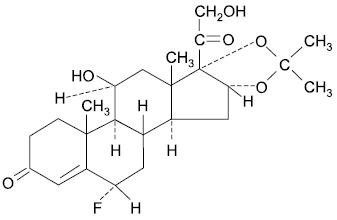Flurandrenolide Cream
Dosage form: cream
Drug class:Topical steroids
Medically reviewed by Drugs.com. Last updated on Mar 22, 2022.
On This Page
Flurandrenolide Cream Description
Flurandrenolide Cream, USP is a potent corticosteroid intended for topical use. Flurandrenolide occurs as white to off-white, fluffy, crystalline powder and is odorless. Flurandrenolide is practically insoluble in water and in ether. One gram of flurandrenolide dissolves in 72 mL of alcohol and in 10 mL of chloroform. The molecular weight of flurandrenolide is 436.52.
The chemical name of flurandrenolide is Pregn-4-ene-3,20-dione, 6-fluoro-11,21-dihydroxy- 16,17-[(1-methylethylidene)bis (oxy)]-, (6α, 11β, 16α)-; its empirical formula is C24H33FO6. The structure is as follows:

Each gram of Flurandrenolide Cream, USP contains 0.5 mg (1.145 μmol; 0.05%) flurandrenolide in an emulsified base composed of cetyl alcohol, citric acid, mineral oil, polyoxyl 40 stearate, propylene glycol, sodium citrate, stearic acid, and purified water.
Flurandrenolide Cream - Clinical Pharmacology
Flurandrenolide Cream, USP is primarily effective because of its anti-inflammatory, antipruritic, and vasoconstrictive actions.
The mechanism of the anti-inflammatory effect of topical corticosteroids is not completely understood. Corticosteroids with anti-inflammatory activity may stabilize cellular and lysosomal membranes. There is also the suggestion that the effect on the membranes of lysosomes prevents the release of proteolytic enzymes and, thus, plays a part in reducing inflammation.
Pharmacokinetics
The extent of percutaneous absorption of topical corticosteroids is determined by many factors, including the vehicle, the integrity of the epidermal barrier, and the use of occlusive dressings.
Topical corticosteroids can be absorbed from normal intact skin. Inflammation and/or other disease processes in the skin increase percutaneous absorption.
Once absorbed through the skin, topical corticosteroids are handled through pharmacokinetic pathways similar to systemically administered corticosteroids. Corticosteroids are bound to plasma proteins in varying degrees. They are metabolized primarily in the liver and then excreted in the kidneys. Some of the topical corticosteroids and their metabolites are also excreted into the bile.



